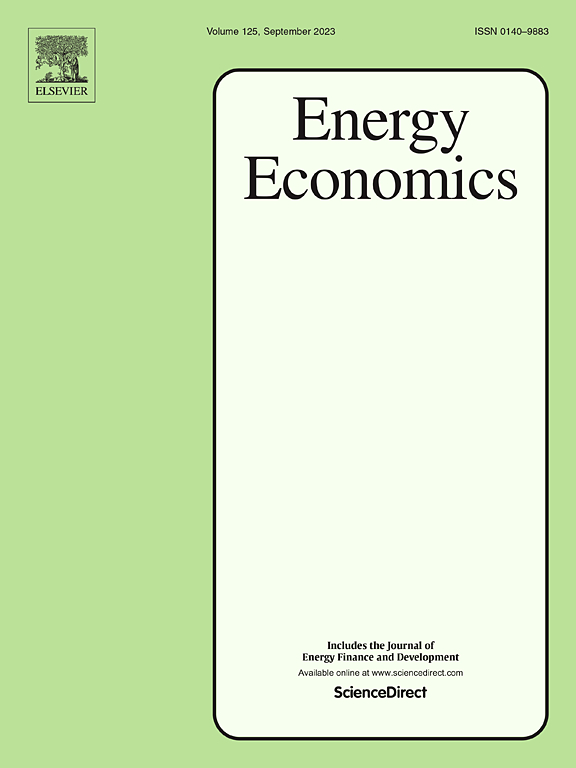英国纸浆、纸张和印刷行业脱碳:通过LMDI和MRIO分析的见解来平衡可持续性和全球竞争力
IF 14.2
2区 经济学
Q1 ECONOMICS
引用次数: 0
摘要
英国的纸浆、造纸和印刷部门(UKPPP)贡献了全国工业二氧化碳排放量的6%。虽然这些排放量自2000年以来有所下降,主要原因是由于全球竞争力挑战而关闭了大约一半的造纸厂,但与其他全球顶级PPP国家(TGPPP)相比,影响排放动态的其他因素(例如碳强度、能源强度、化石燃料依赖、经济结构和活动)仍未进行定量评估。此外,UKPPP依赖于从TGPPP进口。然而,尚未对生态二氧化碳排放交换进行全面建模,并对这些实体之间的部门生产结构和排放动态进行比较。这种分析差距阻碍了对脱碳计划有效性的衡量,影响了更广泛的英国气候政策。因此,本文采用了两步自顶向下的建模方法,利用对数平均可分指数和环境扩展的多区域投入产出框架来研究2000年至2019年期间的部门排放驱动因素。分析表明,在整个20年期间,尽管主要由于固体生物质和沼气比例增加,碳强度总体有所改善,对化石燃料的依赖有所减少,但能源强度提高带来的效率提高对减缓排放的贡献微乎其微。重要的是,尽管UKPPP提高了碳强度,但二氧化碳排放实际上正在泄漏到其他TGPPP,除了俄罗斯,英国是排放的净出口国,这凸显了重新思考当前双边贸易机制的迫切需要。提出了宏观层面的特定行业战略,包括新的循环商业模式、供应链重新配置和基于消费的碳预算,以使UKPPP脱碳并保持其全球竞争力。本文章由计算机程序翻译,如有差异,请以英文原文为准。

Decarbonising the UK pulp, paper and printing sector: Balancing sustainability and global competitiveness through insights from LMDI and MRIO analysis
The United Kingdom's pulp, paper, and printing sector (UKPPP) contributes ∼6 % of the nation's industrial CO2 emissions. While these emissions have declined since 2000, mainly because roughly half its paper mills closed due to global competitiveness challenges, other factors influencing emission dynamics (e.g., carbon intensity, energy intensity, fossil fuel dependency, economic structure, and activities) remain quantitatively unevaluated in comparison to other top global PPP countries (TGPPP). Additionally, the UKPPP relies on imports from TGPPP. Yet, a comprehensive modelling of the ecological CO2 emission exchanges and a comparison of sectoral production structures and emission dynamics between these entities have not been conducted. This analytical gap hinders the gauging of the effectiveness of decarbonisation plans, impacting wider UK climate policy. Consequently, this paper employs a two-step, top-down modelling approach, utilising logarithmic mean divisia index and environmentally-extended multi-region input-output frameworks to examine the sectoral emission driving factors between 2000 and 2019. The analysis reveals that across the aggregate 20-year period, efficiency gains from improved energy intensity contributed minimally to emission mitigation, despite overall improvements in carbon intensity and reduced fossil fuel dependency, primarily induced by an increased proportion of solid biomass and biogas. Importantly, despite the UKPPP's improved carbon intensity, CO2 emissions are effectively leaking to other TGPPP, with the exception of Russia, where the UK is a net exporter of emissions, highlighting a critical need to rethink current bilateral trading mechanisms. Macro-level sector-specific strategies encompassing new circular business models, supply-chain re-configurations, and consumption-based carbon budgeting to both decarbonise the UKPPP and keep it globally competitive are proposed.
求助全文
通过发布文献求助,成功后即可免费获取论文全文。
去求助
来源期刊

Energy Economics
ECONOMICS-
CiteScore
18.60
自引率
12.50%
发文量
524
期刊介绍:
Energy Economics is a field journal that focuses on energy economics and energy finance. It covers various themes including the exploitation, conversion, and use of energy, markets for energy commodities and derivatives, regulation and taxation, forecasting, environment and climate, international trade, development, and monetary policy. The journal welcomes contributions that utilize diverse methods such as experiments, surveys, econometrics, decomposition, simulation models, equilibrium models, optimization models, and analytical models. It publishes a combination of papers employing different methods to explore a wide range of topics. The journal's replication policy encourages the submission of replication studies, wherein researchers reproduce and extend the key results of original studies while explaining any differences. Energy Economics is indexed and abstracted in several databases including Environmental Abstracts, Fuel and Energy Abstracts, Social Sciences Citation Index, GEOBASE, Social & Behavioral Sciences, Journal of Economic Literature, INSPEC, and more.
 求助内容:
求助内容: 应助结果提醒方式:
应助结果提醒方式:


